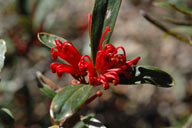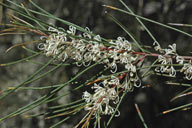

 |
Australian National Botanic Gardens |
 |
sA weekly news sheet prepared by a Gardens' volunteer.
Numbers in square brackets [ ] refer to garden bed Sections.
Plants in flower are in bold type.
9 October 2009
 |
Grevillea dimorpha - click for larger image |
As you leave the Visitors’ Information Centre look up to the right to see the Tumut Grevillea or Grevillea wilkinsonii [Section 174], a large bush with purplish-pink toothbrush flowers. This species is rare and endangered in nature, although it performs well in cultivation. Follow the Main Path across the bridge, past the café and up the hill. Note on the left Leptospermum myrsinoides or Silky Tea Tree [Section 10] with beautiful pink five part flowers. Also on the left is Telopea ‘Canberry Gem’ [Section 30] with bold spires of orange-pink flowers on a vigorous bush.
Further on the left is Grevillea aquifolium [Section 25], a low bush with fluffy reddish heads of spider flowers. Opposite, in contrast, are the acid yellow horizontal heads of Homoranthus sp. [Section 27]. As you cross the road look to your left to see Grevillea dimorpha [Section 25] or Red Spider Flower showing off a myriad of bright red flowers. On the left across the road are the tiny white spider flowers emerging from lime green buds of Grevillea confertifolia [Section 24]. Opposite is Grevillea sericea [Section 26] with attractive pink spider flowers on a slight bush.
There are even more flowering grevilleas worthy of note in this area. Next on the left are several large bushes of Grevillea ‘Bonfire’ [Section 24] with brilliant pinkish red spider flowers on a tall bush with dark green foliage. On the right is Grevillea corrugata [Section 26] with very fine white fluffy blooms on a pale green bush. Also on the right is Grevillea anethifolia [Section 26] with white starbursts of flower. Further along on the right is Grevillea endlicheriana [Section 26] from Western Australia with white balls of spider flowers on long stems above grey foliage. Grevillea ripicola [Section 24] opposite, in contrast, has orange red spider flowers on a low mounded bush.
On the left is the stunning Boronia clavata [Section 24] with lime green flowers on a lime green bush. Bend down to smell the delightful fragrance. Bear left along the road at the Sydney Gully sign to see Dillwynia ramosissima [Section 191h] on the corner with its red and yellow ‘bacon and eggs’ flowers. Next to the Dillwynia is Logania albiflora [Section 191h] with sweetly perfumed sprays of white flowers. Detour up to the right to admire the brilliant gold display of Pultenaea altissima [Section 191h]. It is a stunning sight.
 |
Hakea macraeana - click for larger image |
Return to the road to notice on the left Acacia fimbriata [Section 18] providing a bright yellow splash of colour. Opposite are two shapely trees of Hakea macraeana [Section 20] with branches of curled white blooms on fine weeping foliage. On the right is Acacia rigens [Section 19] with exceptionally large deep gold balls on very fine pale foliage.
Continue down the hill through the Rock Garden to the café and Visitors’ Information Centre noticing on both sides the spectacular arching pink blooms of Indigofera australis [Sections 4 and 15r].
Rosalind Walcott